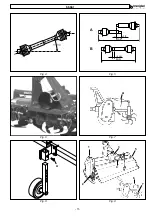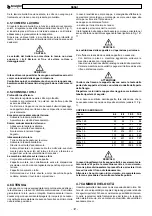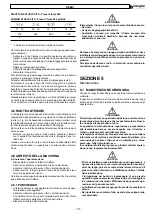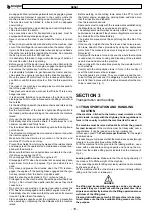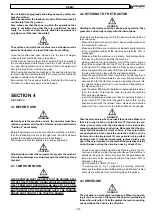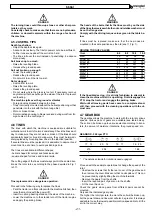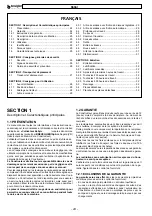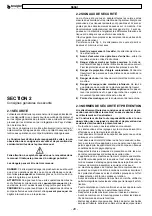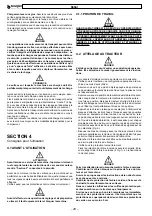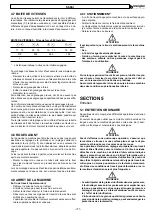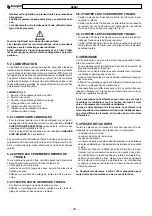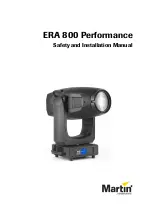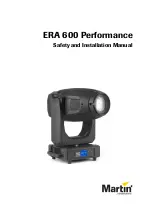
- 18 -
b60pl
moving parts. Wear protective garments such as goggles, gloves
and protective footwear if required in the country where the
machine is used or when working on particular stony ground.
- The machine must be hitched to a tractor with an adequate
power rating.
- Pay the utmost attention when hitching and unhitching the ma-
chine to and from the tractor.
- Any accessories used for transportation purposes must be
equipped with adequate signs and guards.
- Never ever leave the driver’s seat whilst the tractor is operat-
ing.
- When driving round bends with and without the machine, take
care of the centrifugal force exercised when the center of grav-
ity is in a different position, particular when driving round bends.
- Check the rpm rate before inserting the driveline. Do not switch
the 540 rpm rate with the 1000 rpm one.
- It is absolutely forbidden to linger within the range of action of
the machine when this is operating.
- Before you get off the tractor, lower the machine hitched to the
power lift unit, stop the tractor engine, engage the parking brake
and remove the ignition key from the control panel.
- It is absolutely forbidden to get between the tractor and ma-
chine while the engine is running and the driveline engaged.
- Move the power lift control lever to the locked position before
you hitch or unhitch the machine to or from the three-point link-
age.
- The class of the machine’s coupling pins must correspond to
that of the power lift hitch.
- Take great care when you work near the lift links. This is a very
dangerous area.
- It is absolutely forbidden to get between the tractor and the
steerage hoe hitch in order to manoeuvre the lifting control from
the outside.
- Fix the side lifting links with the relative chains and idlers during
the transport phase.
- Set the control lever of the tractor’s hydraulic lifting control in
the locked position when driving on the roads with the machine
raised.
- Only use the driveline recommended by the Manufacturer.
- Periodically check the driveline shield. It must always be in an
optimum condition and firmly fixed.
- Pay the utmost attention to the driveline guard, both during trans-
port and work.
- The driveline must always be mounted and demounted when
the tractor engine is off.
- Make sure that the driveline is mounted on the tractor and
machine PTO in the correct way.
- Prevent the shields from turning by means of the relative chains
and always read the operation and maintenance manual sup-
plied with the driveline.
- Make sure that there are no bystanders or animals in the vicin-
ity before you engage the PTO.
- Do not engage the PTO when the engine is off.
- Disengage the PTO when the driveline is at an excessively wide
angle (never more than 10 degrees, Fig. 4) and when it is not
used.
- Only clean and grease the driveline when the PTO is disen-
gaged, the engine off, the parking brake engaged and the igni-
tion key removed from the tractor’s ignition switch.
- Rest the driveline on its stand (4 Fig. 1) when not used.
- Prolonged use of the machine may cause the gearbox/final drive
(5 Fig. 1). Do not touch these parts just after use as they could
cause burns.
- Do not carry out servicing or cleaning operations unless the
PTO has been disengaged and the tractor engine turned off.
- Periodically check to make sure that the nuts and bolts are well
torqued. Tighten them if necessary.
- Place adequate supports under the machine as a precaution
when servicing or replacing the tines/blades with the machine
raised.
- Before working on the cutting tools, detach the PTO, turn off
the tractor engine, engage the parking brake and make sure
that the tines are at a standstill.
- Use the recommended oils.
- Spare parts must comply with the requirements established by
the Manufacturer. Only use genuine spare parts.
- The safety decals must always be clearly visible. They must be
kept clean and replaced if they become illegible (new ones can
be obtained from the Manufacturer).
- The instruction manual must be kept throughout the life of the
machine.
- If the country in which the machine is used has noise preven-
tion laws, adapt to these provisions by using the appropriate
protections. The measured noise levels are given in section “1.5
Noise level”.
- Comply with the laws in force in the country where the machine
is used when it comes to using and disposing of the products
used to clean and service the machine.
Also comply with the instructions given by the manufacturer of
such products.
- Comply with the anti-pollution laws in force in the country of
use if the machine must be scrapped.
- The side guards are mobile. They are closed around the ma-
chine for transport reasons. It is obligatory to pull them fully out
and to fix them in place with the relative screws before the ma-
chine is used (see Fig. 1).
SECTION 3
Transportation and handling
3.1 TRANSPORTATION AND HANDLING
CAUTION
If the machine, hitched to the tractor, must circulate on the
public roads, comply with the Highway Code regulations in
force in the country in which the machine itself is used.
The machine must be raised at least 40 cm from the ground
for road transport
. If the machine must be transported over a
long distance, it can be loaded on a truck or railway car.
In this case, consult “
1.6 Technical specifications
” for the weight
and dimensions.
This will allow you to make sure that the machine can pass through
tunnels or low constructions without difficulty.
To lift the machine from the ground to the loading platform, use a
crane with an adequate carrying capacity and hook up the ma-
chine from the relative lifting points indicated on the machine (8
Fig. 3).
Loading with a crane.
Make sure that the carrying capacity of
the crane is fit to lift the weight of the machine.
The connecting points for lifting are clearly visible and are marked
by stickers, see Fig. 3.
Lift the machine with the utmost care and move it slowly without
jolting on to the truck or railway car.
DANGER
The lifting and transporting operations can be very danger-
ous unless they are carried out with the greatest care: have
all persons not directly involved in the lifting operations move
well clear of the lifting area.
Clear and delimit the zone to which the machine is to be trans-
ferred. Make sure that the available lifting means are fit for
the purpose.
Summary of Contents for b60pl
Page 4: ... 4 b60pl Fig 3 6 7 4 5 1 2 8 3 ...
Page 5: ...b60pl 5 Fig 8 Fig 7 Fig 4 Fig 5 Fig 6 Fig 9 A 1 2 3 4 5 6 7 A B 1 3 MAX MIN 4 cm A ...
Page 63: ...b60pl 63 Tav 12 ...
Page 64: ... 64 b60pl Tav 13 ...
Page 65: ...b60pl 65 NOTE ...
Page 66: ... 66 b60pl NOTE ...
Page 67: ...b60pl 67 NOTE ...


